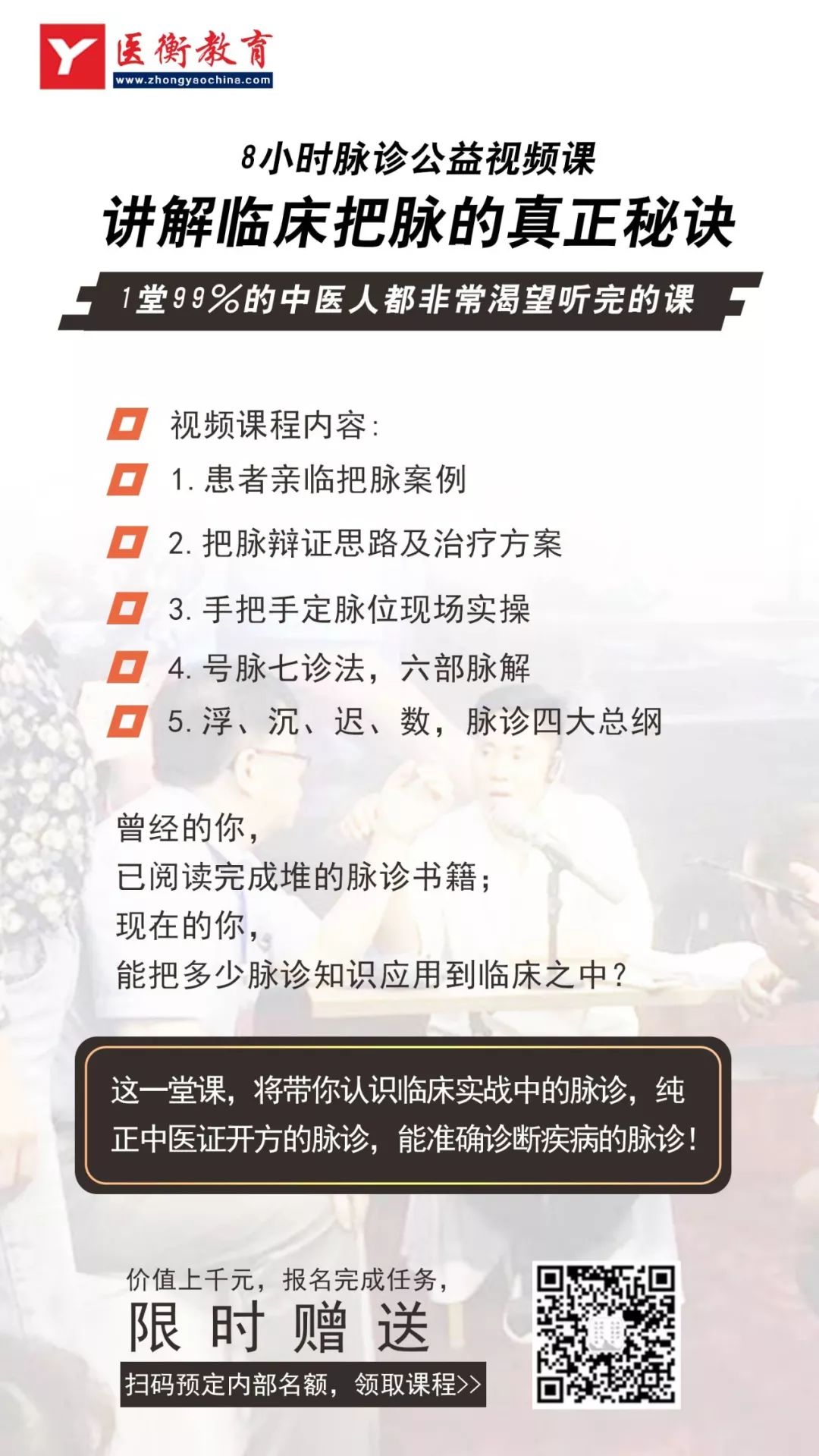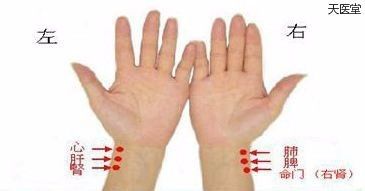Steps of Pulse Diagnosis:
First distinguish floating from sinking, second differentiate deficiency from excess;
Third assess length and shortness, fourth calculate rapidity and slowness;
Fifth observe pulse shape, know them all.
1. First distinguish floating from sinking
What is “first distinguish floating from sinking”? The explanation is as follows:
① First, differentiate whether the pulse is floating or sinking. When palpating the pulse, the fingers gradually probe from the superficial to the deeper layers. Initially, lightly touching the skin (i.e., “lifting”) can reveal whether the pulse is floating; if there is no floating pulse, then apply more pressure (i.e., “searching”), at this level, many pulse types can be felt; then the third force, “pressing,” checks for sinking pulses. Therefore, “first distinguish floating from sinking” is about detecting the position of the pulse according to the order of finger pressure.
② During the differentiation of floating and sinking, one can identify the types of pulses related to floating or sinking, which are:
Floating pulse types—floating pulse, soft pulse, leather pulse, hollow pulse, scattered pulse;
Sinking pulse types—sinking pulse, firm pulse, hidden pulse.
③ After distinguishing between floating and sinking pulses, it can indicate whether the condition is an exterior or interior syndrome in diagnostic assessment.
2. Second differentiate deficiency from excess
What is “second differentiate deficiency from excess”? The explanation is as follows:
① After completing the distinction between floating and sinking, knowing whether the condition is exterior or interior, it is also necessary to understand the relationship between the righteous qi and pathogenic qi (deficiency syndrome or excess syndrome). The distinction between excess and deficiency in pulse characteristics is the difference between strong and weak pulses. Thus, the second step in pulse diagnosis is to differentiate the pulse’s deficiency from excess (strength from weakness).
② When differentiating the pulse’s deficiency or excess (i.e., strength or weakness), one can also distinguish other pulse types related to deficiency and excess. Deficiency pulse types—deficient pulse, faint pulse, weak pulse; excess pulse type—excess pulse.
3. Third assess length and shortness
What is “third assess length and shortness”? The explanation is as follows:
① Long and short pulses are two types of pulse shapes with very distinct characteristics, which can be distinguished by the fingers touching the pulse vessel.
② When examining the cun, guan, and chi positions, first distinguish the pulse types as long or short, and then further assess the pulses at these positions.
③ When distinguishing long and short pulses, one can simultaneously observe other related pulse types, such as: long pulse types—long pulse, string-like pulse, fine pulse; short pulse types—short pulse.
4. Fourth calculate rapidity and slowness
What is “fourth calculate rapidity and slowness”? The explanation is as follows:
① After determining the pulse position (the position distinguishing length and string-like quality, observing floating and sinking) and pulse quality (which also includes deficiency and excess), the next step is to address the frequency and rhythm of the pulse.
② There are eight pulse types related to pulse frequency and rhythm:
Pulse rate—rapid pulse, quick pulse, slow pulse, leisurely pulse;
Pulse rhythm—hurried pulse, knotted pulse, intermittent pulse, scattered pulse.
5. Fifth observe pulse shape
What is “fifth observe pulse shape”? The explanation is as follows:
① After completing the above four steps, one can distinguish 23 types of pulses, and the remaining four types are primarily characterized by pulse shape: surging, slippery, rough, and tight.
② Except for the unique surging pulse, slippery and rough are relative, while tight and rough pulses are distinguished from each other. The surging pulse often appears in summer or in febrile diseases (yangming heat excess or the qi stage of warm diseases), or in the final stages of critical illness, which can be inferred from other information.
6. Know them all
What is “know them all”? The explanation is as follows:
① This is the final review stage. At this step, one should have a clear understanding of the pulse position (left and right, up and down), pulse quality (deficiency and excess), pulse rate (rapidity and slowness), pulse rhythm (knotted and intermittent), and pulse shape (surging, tight, slippery, rough), no longer being “difficult to clarify under the fingers, hard to understand in the heart”.
② All information should be integrated and analyzed to draw conclusions. The method for drawing conclusions is:
A: Filter all pulse information through the definitions of 28 pulse types in the mind, using independent pulse names where applicable; otherwise, use the combined pulse method to define the pulse.
B: Examine the degree of consistency between the obtained pulse information and the information obtained from observation, listening, and inquiry, then determine the authenticity of the pulse and decide its relevance in treatment decisions.
C: Carefully differentiate the cun, guan, and chi issues: when the condition is complex, the cause is unclear, or the location is ambiguous, carefully examine the cun, guan, and chi; otherwise, they can be undifferentiated.
For example:
First step floating and sinking, measured: pulse position—floating;
Second step deficiency and excess, measured: pulse quality—deficient, soft;
Third step length and shortness, measured: pulse position—cun, guan, chi all present;
Fourth step calculate rapidity and slowness, measured: pulse rhythm, pulse rate—normal;
Fifth step pulse shape, measured: pulse shape—like a silk thread;
Sixth step integration, additional information: symptoms of weakness in the limbs, pale yellow complexion, heavy head and drowsiness, bland taste in the mouth, loose stools, scanty urination, pale red tongue, thin white greasy coating;
Conclusion: using the combined method to judge the pulse: floating fine—incorrect! Using independent naming method to judge the pulse: soft—correct.
The above is my personal experience with pulse diagnosis, which is very handy in clinical practice; sometimes, when friends question the mysteries of TCM techniques, it also leaves them in awe! The prerequisites for mastering this technique are: 1) truly understanding the concept of each pulse type; 2) extensive clinical practice.

Pulse diagnosis is a fundamental technique in TCM. Currently, TCM pulse diagnosis generally refers to cun kou pulse diagnosis, often based on the 28 pulse types summarized by the medical sage Li Shizhen, which is also the standard in many current university textbooks. This article is based on this standard. According to student requests and my own views, I have revised and clarified the following, and I welcome critiques and discussions from fellow TCM practitioners.
1. Basic theory of pulse diagnosis
1. The significance of pulse palpation:
Pulse diagnosis is an indispensable diagnostic step and content in TCM clinical practice. The importance of pulse diagnosis lies in the fact that pulse characteristics can convey physiological and pathological information from various parts of the body, serving as a window to observe internal functional changes, providing important evidence for diagnosing diseases. In summary, it includes the following points:
①Distinguishing the location of the disease: for example, floating pulse indicates exterior syndrome, sinking pulse indicates interior syndrome.
②Distinguishing the nature of the disease: for example, slow pulse and tight pulse indicate cold, rapid pulse and slippery pulse indicate heat.
③Distinguishing the strength of righteous and pathogenic qi: for example, deficient pulse indicates deficiency of righteous qi, excess pulse indicates excess of pathogenic qi.
④Distinguishing the progression or regression of the disease: for example, in externally contracted febrile diseases, if the heat gradually recedes, the pulse becomes more moderate, indicating a sign of recovery.
2. Characteristics of TCM pulse palpation
① The elements constituting TCM pulse characteristics include five aspects: pulse position, rate, rhythm, shape, and strength (qi strength).
② Pulse diagnosis is a profound experiential medical knowledge with many techniques; one must be familiar with the theory and then practice diligently.
③ There may be inconsistencies between pulse characteristics and symptoms; during diagnosis, one must apply the method of prioritizing symptoms over pulse characteristics.
3. The selection and prioritization of pulse characteristics (the correspondence and prioritization of pulse and symptoms)
The selection and prioritization of pulse characteristics refer to discerning the correspondence between pulse and symptoms to determine the progression or regression of the disease and when to prioritize pulse or symptoms. This indicates that pulse characteristics are one aspect of disease manifestation, not the entirety; pulse characteristics should only be considered as one aspect of information for diagnosis. A comprehensive application of the four diagnostic methods is necessary to arrive at a correct conclusion.
① Correspondence of pulse and symptoms
The correspondence of pulse and symptoms refers to discerning the relationship between pulse and symptoms (the relationship indicates whether the disease is progressing smoothly or not, and the relationship between pathogenic and righteous qi), for example:
Pulse and symptoms correspond—pulse and symptoms are consistent: exterior syndrome shows floating pulse, heat syndrome shows rapid pulse as a smooth progression.
Pulse and symptoms do not correspond—pulse and symptoms are inconsistent, for example, exterior syndrome shows sinking pulse, heat syndrome shows slow pulse as a regression.
Pulse and symptoms correspond—acute or new diseases show floating, surging, rapid, and excess pulses as a smooth progression, indicating that righteous qi is strong enough to resist pathogens. Chronic or old diseases show sinking, faint, fine, and weak pulses as a smooth progression, indicating that the pathogenic qi is declining and recovery is hopeful.
Pulse and symptoms do not correspond—new diseases show sinking, fine, faint, and weak pulses, indicating that righteous qi has declined. Chronic diseases show floating, surging, and excess pulses as a regression, indicating that righteous qi has declined and pathogenic qi has not retreated.
② Prioritizing symptoms over pulse, or prioritizing pulse over symptoms (true symptoms, false pulse; false symptoms, true pulse)
True symptoms, false pulse—prioritizing symptoms over pulse, meaning not considering the significance of pulse characteristics, but rather focusing on the significance of symptoms. For example: symptoms show abdominal distension and fullness, pain with pressure, dry stools, red tongue with thick yellow coating, pulse is sinking and fine—true symptoms indicate interior heat syndrome, prioritize symptoms; sinking and fine pulse is a false pulse (sinking and fine pulse indicates deficiency and cold); in this case, prioritize symptoms.
False symptoms, true pulse—prioritizing pulse over symptoms, meaning not considering the significance of symptoms, but rather focusing on the significance of pulse characteristics. For example: symptoms show cold limbs, constipation, abdominal pain and distension, pulse is slippery and rapid—false symptoms (seem to indicate cold excess), prioritize pulse; slippery and rapid pulse is true, indicating interior heat accumulation, in this case, prioritize pulse.
4. Application of the three positions and nine conditions
In difficult cases, use the left hand for heart, liver, and kidney, and the right hand for lung, spleen, and life, and apply the three positions for lifting and searching; generally, the nine conditions are not used.
5. Normal pulse characteristics—stomach, spirit, root
In TCM theory, normal pulse characteristics can be summarized as “stomach, spirit, root.” The characteristics of normal pulse are: the cun, guan, and chi positions all have pulses, neither floating nor sinking, neither fast nor slow, with a frequency of 4-5 beats per breath, equivalent to 72-80 beats per minute (for adults), neither large nor small, calm and gentle, with consistent rhythm, and the chi position has a certain strength when pressed, varying with physiological activities, climate, seasons, and environment.
① Having stomach:“Having stomach” refers to the feeling of calmness, gentleness, and smoothness under the fingers. Normal pulse is neither floating nor sinking, neither fast nor slow, comes and goes calmly, with consistent rhythm; even in pathological pulses, regardless of floating or sinking, slow or rapid, if there is a sense of harmony, it is still considered “having stomach qi.”
② Having spirit:“Having spirit” refers to a pulse rate that is regular, gentle, and strong. Even if the pulse is weak, it should not be completely disordered and without strength; a string-like or firm pulse still feels gentle, all belong to “having spirit qi.” Conversely, if the pulse is disordered, varying in strength, rapidity, and continuity, or if it is overly firm or weak, it indicates “lacking spirit.”
③ Having root:“Having root” is primarily manifested by a strong and continuous chi pulse. If the condition is severe, but the chi pulse can still be felt, it indicates that kidney qi is not exhausted, and there is still vitality; conversely, if the chi pulse cannot be felt, it indicates that kidney qi has failed, and the condition is critical.
6. Physiological variations of pulse characteristics
① Individual factors: gender, age, constitution, pulse position (oblique pulse, reverse guan pulse) affect pulse characteristics.
② External factors: emotions, work-rest balance, diet, seasons, day-night cycles, geographical environment, etc., affect pulse characteristics.

2. Pathological pulse characteristics analysis
1. Analysis of the 28 pulses (independent pulse types)
① Pulses primarily characterized by abnormal pulse position—floating, soft, hollow, leather, sinking, hidden, firm, short, long
“Abnormal pulse position” concept: refers to changes in the position of the pulse body, such as vertical or horizontal shifts.
For example:
1) Floating pulse: pulse characteristics—easily felt with light pressure, insufficient with heavy pressure. Indicates exterior syndrome, deficiency syndrome.
2) Soft pulse: pulse characteristics—floating and fine, cannot withstand heavy pressure, not prominent with heavy pressure. Indicates deficiency syndrome, damp syndrome.
Soft pulse analysis: pulse is at a shallow level, easily felt with light pressure, insufficient with heavy pressure; pulse body is fine like a thread; pulse vessel has weak elasticity.
3) Sinking pulse: pulse characteristics—cannot be felt with light pressure, only felt with heavy pressure. Indicates interior syndrome.
Sinking pulse analysis: pulse is at a deep level, cannot be felt with light or moderate pressure, only with heavy pressure.
4) Short pulse: pulse characteristics—both ends are short, cannot fill the entire area. Indicates qi disease.
Short pulse analysis: only noticeable pulsation at the guan position, cun and chi positions are vague or not obvious.
5) Long pulse: pulse characteristics—both ends are straight, exceeding the normal position. Indicates long and strong pulses are due to excess pathogenic qi. Long and soft pulses are normal.
Long pulse analysis: pulse vessel extends beyond the cun, guan, and chi positions, pulse body is long and straight.
6) Hollow pulse: pulse characteristics—floating, large, hollow in the middle, like pressing on a scallion tube. Indicates blood loss, yin injury.
Hollow pulse analysis: pulse is floating, easily felt with light pressure; pulse shape shows vessels on both sides, but hollow in the middle.
7) Leather pulse: pulse characteristics—floating and broad, hollow in the middle but firm on the outside, like pressing on a drum skin. Indicates severe loss of essence and blood, yang qi floating outward.
Leather pulse analysis: pulse is floating, easily felt with light pressure; pulse vessel is hard on the outside but hollow in the middle, responding poorly to pressure; the entire pulse vessel feels like pressing on a drum skin.
8) Hidden pulse: pulse characteristics—requires heavy pressure to feel, may not be felt at all; its position is deeper than sinking pulse. Indicates closed pathogenic factors; syncope; extreme pain.
Hidden pulse analysis: requires heavy pressure to feel the pulse, may still be difficult to detect.
9) Firm pulse: pulse characteristics—combines characteristics of sinking, string-like, excess, large, and long pulses, firm and unyielding. Indicates internal cold and excess; hernia and masses.
Firm pulse analysis: combines the analysis of sinking, string-like, excess, and long pulses. The “large pulse” characteristic indicates a wide pulse body, but the pulse strength is not overwhelming.
② Pulses primarily characterized by abnormal pulse rate—rapid, quick, slow, leisurely
“Abnormal pulse rate” concept: refers to pulse frequency exceeding normal or being below normal. For example:
10) Rapid pulse: pulse characteristics—pulse rate is fast, between 90-139 beats per minute (more than 5 beats per breath), rhythm is regular. Indicates heat syndrome. (“One breath” refers to the time of a normal person’s inhalation and exhalation.)
11) Slow pulse: pulse characteristics—pulse is slow, less than 4 beats per breath, rhythm is regular. Indicates cold syndrome.
12) Quick pulse: pulse characteristics—pulse is urgent, more than 140 beats per minute (7-8 beats per breath). Indicates yang counteracting yin, vital energy is about to collapse.
13) Leisurely pulse: pulse characteristics—4 beats per breath, comes and goes slowly or the pulse shape is relaxed, lacking sufficient tension; pulse rate is slightly slower than normal pulse but faster than slow pulse, indicates damp syndrome; spleen and stomach deficiency; after prolonged illness and treatment, it indicates recovery of righteous qi.
③ Pulses primarily characterized by abnormal pulse rhythm—hurried, knotted, intermittent.
“Abnormal pulse rhythm” concept: refers to irregular pulse rhythm. For example:
14) Hurried pulse: pulse characteristics—rapid and irregular, with intermittent pauses. Indicates excessive yang heat.
Hurried pulse analysis: pulse rate is rapid, greater than 90 beats per minute, with irregular pauses.
15) Knotted pulse: pulse characteristics—pulse is slow with intermittent stops, with no fixed number of stops. Indicates excessive yin, qi stagnation, cold phlegm, blood stasis, masses, and food stagnation.
Knotted pulse analysis: pulse is slow with irregular pauses, pulse rate is less than or equal to 90 beats per minute, with irregular pauses.
16) Intermittent pulse: pulse characteristics—pulse stops intermittently, with a fixed number of stops, returning after a long time. Indicates weak organ qi, pain, fright, or injury from falls.
Intermittent pulse analysis: pulse rate is normal, 60-90 beats per minute. Pulse rhythm has regular pauses.
④ Pulses primarily characterized by abnormal pulse shape—surging, fine, slippery, rough, string-like, tight
“Abnormal pulse shape” concept: refers to the pulse’s shape during pulsation, including amplitude and speed of rise and fall, surface smoothness, elasticity, volume, and area under the fingers. For example:
17) Surging pulse: pulse characteristics—pulse body is wide, resembling a flood, coming strong and going weak. Indicates excessive yang heat, residual yang escaping.
Surging pulse analysis: pulse body is wide; amplitude is large; speed of rise and fall is very fast, like “coming with great momentum and receding with diminished force”; pulse is strong and not weak.
18) Fine pulse: pulse characteristics—pulse body is fine, resembling a silk thread, clearly felt under the fingers. Indicates deficiency syndrome, damp syndrome.
Fine pulse analysis: pulse feels fine like a silk thread during pulsation, with a fine line sensation.
19) Slippery pulse: pulse characteristics—pulse comes and goes smoothly and roundly, like beads rolling, feeling round under the fingers. Indicates phlegm syndrome, food accumulation, excess heat syndrome (also seen in normal individuals and pregnant women).
Slippery pulse analysis: pulse feels smooth and flowing under the fingers, with a sense of fluidity; it feels like beads rolling quickly.
20) Rough pulse: pulse characteristics—comes and goes with difficulty, feeling rough and lacking smoothness (opposite of slippery pulse), like “a light knife scraping bamboo.” Indicates roughness and strength for excess syndrome, blood stasis, food accumulation, phlegm obstruction; rough and weak for essence injury, blood deficiency.
Rough pulse analysis: pulse feels rough during pulsation, flowing with difficulty, with a surface feeling of fine serrations.
21) String-like pulse: pulse characteristics—long and straight, like pressing on a guitar string. Indicates liver and gallbladder diseases, pain, phlegm and drink, malaria.
String-like pulse analysis: pulse vessel is long and straight; under the fingers, it feels like a guitar string, with slightly higher tension.
22) Tight pulse: pulse characteristics—pulse comes tight and urgent, resembling a twisted rope. Indicates cold syndrome, pain syndrome, food stagnation in the gastrointestinal tract.
Tight pulse analysis: pulse has high tension, with a sensation of rotation during pulsation, feeling strong under the fingers.
23) Moving pulse: pulse characteristics—pulse shape like a bean, slippery and rapid, short, especially noticeable at the guan position. Indicates pain syndrome, fright.
Moving pulse analysis: the noticeable pulsation is mainly at one position, often seen at the guan position (i.e., short); surface is smooth, speed is fast (i.e., slippery and rapid); pulsation feels like beans jumping.
⑤ Pulses primarily characterized by abnormal pulse quality—excess, deficiency, weak, faint, scattered
“Abnormal pulse quality” concept: refers to changes in the pulse’s strength and quality.
24) Excess pulse: pulse characteristics—strong and full at the cun, guan, and chi positions. Indicates excess syndrome.
Excess pulse analysis: pulse body is long and large, with a feeling of fullness, pulse strength is strong, and at the cun, guan, and chi positions, it is strong when lifted and pressed.
25) Deficient pulse: pulse characteristics—during pulsation, there is a sense of emptiness and weakness. Indicates deficiency syndrome.
Deficient pulse analysis: pulse strength is weak, with a sense of emptiness; lifting, pressing, and searching all feel weak.
26) Weak pulse: pulse characteristics—extremely fine, soft, and weak. Indicates deficiency of qi and blood; yang deficiency.
Weak pulse analysis: pulse is deep (i.e., sinking pulse), during pulsation, it feels fine like a silk thread (i.e., fine pulse); pulse elasticity is soft; pulse strength is extremely weak.
27) Faint pulse: pulse characteristics—pulse shape is very small, pulse quality is weak, pressing it feels like it might disappear, barely perceptible. Indicates severe deficiency of qi and blood; declining yang qi.
Faint pulse analysis: pulse feels like a fine line, lacking strength and energy, seeming to be there but not.
28) Scattered pulse: pulse characteristics—floating and scattered without root, pressing slightly makes it disappear, with irregular beats. Indicates pulse is floating (i.e., easily felt with light pressure), pressing slightly makes it disappear; pulse beats are irregular, varying within the same “breath”.
2. Strange pulses: including critical pulses, often seen in heart disease, heart failure, arrhythmia, such as boiling pot pulse, leaking roof pulse, sparrow pecking pulse, knotting pulse, fish swimming pulse, shrimp swimming pulse, stone bouncing pulse.
3. Combined pulses
① “Combined pulses” concept: combined pulses refer to the simultaneous presence of independently named pulse types, such as: floating tight, floating leisurely, floating rapid, floating slippery, sinking slow, string-like rapid, slippery rapid, surging rapid, sinking string-like, sinking rough, string-like fine, sinking leisurely, sinking fine, string-like slippery, etc.
② Main diseases of combined pulses: the combined diseases of each pulse type. For example: floating rapid = floating pulse + rapid pulse, indicating exterior heat.
|
I Copyright Statement: Respect knowledge and labor, please retain copyright information when reprinting. The copyright of the content published on this platform belongs to the relevant rights holders. If there are any improper uses, please feel free to contact us for negotiation. I Submission and cooperation email:[email protected] 【Caution Statement】 All works not marked as original are reprinted, translated, or excerpted from other media. The purpose of reprinting, translating, or excerpting is to convey more information and does not represent the views of this site or its sub-sites, nor does it take responsibility for their authenticity. Other media, public accounts, or individuals must retain the source of this site when reprinting or using, and bear legal responsibility. This subscription account maintains neutrality regarding the statements and judgments made in the text and does not provide any express or implied guarantees regarding the accuracy, reliability, or completeness of the content included. 【Special Reminder】: If you do not wish for your work to appear on this site, please contact us to request its removal. |
Currently, over 100,000 people have followed and joined us

















See more latest information on TCM, Chinese medicine, hygiene, and health.
Please long press the QR code below to follow
Recommended excellent TCM public WeChat professional platform
 Public account ID:zyjyccbk Long press the QR code above to follow, “the treasure trove of experience passed down from famous old TCM practitioners” welcomes you!
Public account ID:zyjyccbk Long press the QR code above to follow, “the treasure trove of experience passed down from famous old TCM practitioners” welcomes you!
Long press the QR code above to follow, “National TCM Development Cooperation Information Sharing Platform“

TCM, clinical, oral practitioner examination, TCM specialty, licensed pharmacist, health management specialist, health qualification examination





